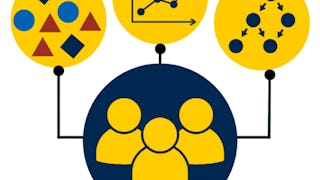In “Applied Unsupervised Learning in Python,” you will learn how to use algorithms to find interesting structure in datasets. You will practice applying, interpreting, and refining unsupervised machine learning models to solve a diverse set of problems on real-world datasets.



Applied Unsupervised Learning in Python
Dieser Kurs ist Teil von Spezialisierung More Applied Data Science with Python

Dozent: Kevyn Collins-Thompson
Bei  enthalten
enthalten
Empfohlene Erfahrung
Was Sie lernen werden
Apply unsupervised learning methods, such as dimensionality reduction, manifold learning, and density estimation, to transform and visualize data.
Understand, evaluate, optimize, and correctly apply clustering algorithms using hierarchical, partitioning, and density-based methods.
Use topic modeling to find important themes in text data and use word embeddings to analyze patterns in text data.
Manage missing data using supervised and unsupervised imputation methods, and use semi-supervised learning to work with partially-labeled datasets.
Kompetenzen, die Sie erwerben
- Kategorie: Dimensionality Reduction
- Kategorie: Machine Learning Algorithms
- Kategorie: Data Science
- Kategorie: Unsupervised Learning
- Kategorie: Text Mining
- Kategorie: Feature Engineering
- Kategorie: Supervised Learning
- Kategorie: Natural Language Processing
- Kategorie: Data Manipulation
- Kategorie: Statistical Machine Learning
- Kategorie: Machine Learning
- Kategorie: Anomaly Detection
Wichtige Details

Zu Ihrem LinkedIn-Profil hinzufügen
Juni 2025
21 Aufgaben
Erfahren Sie, wie Mitarbeiter führender Unternehmen gefragte Kompetenzen erwerben.

Erweitern Sie Ihre Fachkenntnisse
- Lernen Sie neue Konzepte von Branchenexperten
- Gewinnen Sie ein Grundverständnis bestimmter Themen oder Tools
- Erwerben Sie berufsrelevante Kompetenzen durch praktische Projekte
- Erwerben Sie ein Berufszertifikat zur Vorlage

In diesem Kurs gibt es 4 Module
Welcome to Module 1! In this module, we will learn the basic unsupervised learning methods that focus on transformation of data: dimensionality reduction, manifold learning, and density estimation. We will be using realistic datasets for our analyses, implemented using the scikit-learn library. At the end of this Module, our assignment is to apply Principal Components Analysis to gain insight into a large real-world dataset. We will use manifold learning methods such as t-SNE to visualize complex structure, and use kernel density estimation to estimate probabilities of conditional events. Let’s begin!
Das ist alles enthalten
18 Videos7 Lektüren7 Aufgaben1 Programmieraufgabe1 Diskussionsthema1 Plug-in
Welcome to Module 2! In this module’s module, we will learn about clustering—another critical and widely-used unsupervised learning method. We will learn about the most important families of clustering algorithms, such as hierarchical methods (agglomerative bottom-up, divisive top-down), partitioning methods (k-means, k-medoids) and density-based methods (DBSCAN). We will also gain awareness of how to evaluate and optimize cluster quality. At the end of this module, our assignment is to apply a variety of these clustering approaches to realistic datasets using SciKit-Learn's clustering capabilities. Let’s begin!
Das ist alles enthalten
10 Videos3 Lektüren5 Aufgaben1 Programmieraufgabe1 Plug-in
Welcome to Module 3! In this module’s module, we will learn about estimating latent variables—another important area of unsupervised learning, especially for text-based applications. We will focus first on the topic of text representations. Topic modeling is another form of latent variable estimation, which we will learn about via two different methods: Latent Dirichlet Allocation (LDA) and Non-Negative Matrix Factorization. We will also survey word embeddings to learn how to represent words with vectors in semantically useful ways. At the end of this module, our assignment is to solve problems through analyzing topic structure in a large document collection, and applying word embeddings to an NLP-related task. Let’s begin!
Das ist alles enthalten
8 Videos2 Lektüren5 Aufgaben1 Programmieraufgabe1 Plug-in
Welcome to Module 4, our last module of the course! We wrap up our course by learning about how unsupervised methods can be integrated with supervised learning methods to improve prediction performance. A key topic this module in that direction covers imputation methods for dealing with missing data. We will also look at various special topics, including extensions of unsupervised learning that are used at the cutting edge of today's technology: semi-supervised learning and self-supervised learning. At the end of this module, our assignment is to apply methods and techniques for imputing missing data and semi-supervised learning, with the underlying theme being how unsupervised learning can improve supervised learning. Let’s begin!
Das ist alles enthalten
7 Videos3 Lektüren4 Aufgaben1 Programmieraufgabe1 Plug-in
Erwerben Sie ein Karrierezertifikat.
Fügen Sie dieses Zeugnis Ihrem LinkedIn-Profil, Lebenslauf oder CV hinzu. Teilen Sie sie in Social Media und in Ihrer Leistungsbeurteilung.
Dozent

Mehr von Machine Learning entdecken

University of Michigan

University of Michigan

University of Michigan
Warum entscheiden sich Menschen für Coursera für ihre Karriere?





Neue Karrieremöglichkeiten mit Coursera Plus
Unbegrenzter Zugang zu 10,000+ Weltklasse-Kursen, praktischen Projekten und berufsqualifizierenden Zertifikatsprogrammen - alles in Ihrem Abonnement enthalten
Bringen Sie Ihre Karriere mit einem Online-Abschluss voran.
Erwerben Sie einen Abschluss von erstklassigen Universitäten – 100 % online
Schließen Sie sich mehr als 3.400 Unternehmen in aller Welt an, die sich für Coursera for Business entschieden haben.
Schulen Sie Ihre Mitarbeiter*innen, um sich in der digitalen Wirtschaft zu behaupten.
Häufig gestellte Fragen
Access to lectures and assignments depends on your type of enrollment. If you take a course in audit mode, you will be able to see most course materials for free. To access graded assignments and to earn a Certificate, you will need to purchase the Certificate experience, during or after your audit. If you don't see the audit option:
The course may not offer an audit option. You can try a Free Trial instead, or apply for Financial Aid.
The course may offer 'Full Course, No Certificate' instead. This option lets you see all course materials, submit required assessments, and get a final grade. This also means that you will not be able to purchase a Certificate experience.
When you enroll in the course, you get access to all of the courses in the Specialization, and you earn a certificate when you complete the work. Your electronic Certificate will be added to your Accomplishments page - from there, you can print your Certificate or add it to your LinkedIn profile. If you only want to read and view the course content, you can audit the course for free.
If you subscribed, you get a 7-day free trial during which you can cancel at no penalty. After that, we don’t give refunds, but you can cancel your subscription at any time. See our full refund policy.
Weitere Fragen
Finanzielle Unterstützung verfügbar,

